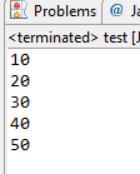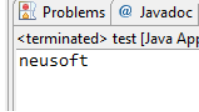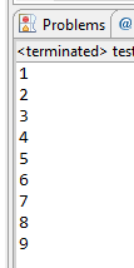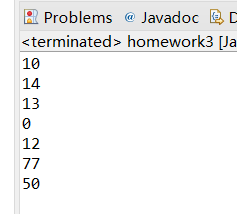Java第八次上机作业
1、编写一个简单程序,要求数组长度为5,分别赋值10,20,30,40,50,在控制台输出该数组的值。(知识点:数组定义和创建、一维数组初始化)
public class test { /** * @param args */ public static void main(String[] args) { // TODO Auto-generated method stub int a[] = { 10, 20, 30, 40, 50 }; for (int i = 0; i < a.length; i++) { System.out.println(a[i]); } } }

2、将一个字符数组的值(neusoft)拷贝到另一个字符数组中。(知识点:数组复制)
public class test { /** * @param args */ public static void main(String[] args) { // TODO Auto-generated method stub String[] a = { "neusoft" }; String[] b = new String[a.length]; System.arraycopy(a, 0, b, 0, a.length); for (String string : b) { System.out.println(string); } } }

3、给定一个有9个整数(1,6,2,3,9,4,5,7,8)的数组,先排序,然后输出排序后的数组的值。(知识点:Arrays.sort排序、冒泡排序)
import java.util.Arrays; public class test { /** * @param args */ public static void main(String[] args) { // TODO Auto-generated method stub int a[] = { 1, 6, 2, 3, 9, 4, 5, 7, 8 }; Arrays.sort(a); for (int i : a) { System.out.println(i); } } }
public class test { /** * @param args */ public static void main(String[] args) { // TODO Auto-generated method stub int a[] = { 1, 6, 2, 3, 9, 4, 5, 7, 8 }; for (int i = 0; i < a.length - 1; i++) { for (int j = 0; j < a.length - 1 - i; j++) { if (a[j] > a[j + 1]) { int temp = a[j]; a[j] = a[j + 1]; a[j + 1] = temp; } } } for (int i : a) { System.out.println(i); } } }

4、 输出一个double型二维数组(长度分别为5、4,值自己设定)的值。(知识点:数组定义和创建、多维数组初始化、数组遍历)
public class test { /** * @param args */ public static void main(String[] args) { // TODO Auto-generated method stub double a[][] = { { 1, 2, 3, 4 }, { 5, 6, 7, 8 }, { 9, 10, 11, 12 }, { 13, 14, 15, 16 }, { 17, 18, 19, 20 } }; for (int i = 0; i < a.length; i++) { for (int j = 0; j < a[i].length; j++) { System.out.print(a[i][j] + " "); } System.out.println(); } } }

5、 在一个有8个整数(18,25,7,36,13,2,89,63)的数组中找出其中最大的数及其下标。(知识点:数组遍历、数组元素访问)
public class test { /** * @param args */ public static void main(String[] args) { // TODO Auto-generated method stub int a[] = { 18, 25, 7, 36, 13, 2, 89, 63 }; int max = 0, index = 0; for (int i = 0; i < a.length; i++) { if (a[i] > max) { max = a[i]; index = i; } } System.out.println("最大数是" + max + "下标是" + index); } }

6、将一个数组中的元素逆序存放(知识点:数组遍历、数组元素访问)
import java.util.Scanner; public class test { /** * @param args */ public static void main(String[] args) { // TODO Auto-generated method stub Scanner input = new Scanner(System.in); int[] a = new int[5]; for (int i = 0; i < a.length; i++) { a[i] = input.nextInt(); } int temp; for (int i = 0; i < a.length / 2; i++) { temp = a[i]; a[i] = a[a.length - i - 1]; a[a.length - i - 1] = temp; } for (int i = 0; i < a.length; i++) { System.out.print(a[i] + " "); } } }

7. 将一个数组中的重复元素保留一个其他的清零。(知识点:数组遍历、数组元素访问)
public class homework3 { /** * @param args */ public static void main(String[] args) { // TODO Auto-generated method stub int a[] = { 10, 14, 13, 14, 12, 77, 50 }; for (int i = 0; i < a.length; i++) { for (int j = 0; j < a.length; j++) { if (a[i] == a[j] && i != j) a[j] = 0; } } for (int i : a) { System.out.println(i); } } }

8、给定一维数组{ -10,2,3,246,-100,0,5},计算出数组中的平均值、最大值、最小值。(知识点:数组遍历、数组元素访问)
public class test { /** * @param args */ public static void main(String[] args) { // TODO Auto-generated method stub int a[] = { -10, 2, 3, 246, -100, 0, 5 }; int avg = 0, max = 0, min = 0; int sum = 0; for (int i = 0; i < a.length; i++) { sum += a[i]; avg = sum / 7; if (a[i] > max) { max = a[i]; } if (a[i] < min) { min = a[i]; } } System.out.println("平均数" + avg + "最大" + max + "最小" + min); } }

9、使用数组存放裴波那契数列的前20项 ,并输出
public class test { /** * @param args */ public static void main(String[] args) { // TODO Auto-generated method stub int[] x = new int[20]; x[0] = 1; x[1] = 1; for (int i = 2; i < x.length; i++) { x[i] = x[i - 1] + x[i - 2]; } for (int i = 0; i < 8; i++) { System.out.print(x[i] + " "); } } }

10、生成一个长度为10的随机整数数组(每个数都是0-100之间),输出,排序后,再输出
import java.util.Arrays; import java.util.Random; public class test { public static void main(String[] args) { Random r = new Random(); int x[] = new int[10]; for (int i = 0; i < x.length; i++) { x[i] = r.nextInt(101); } for (int i = 0; i < x.length; i++) { System.out.print(x[i] + " "); } System.out.println("排序后:"); Arrays.sort(x); for (int i = 0; i < x.length; i++) { System.out.print(x[i] + " "); } } }


